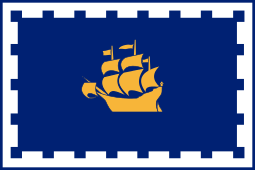Université Laval
 | |
| Motto | Deo favente haud pluribus impar |
|---|---|
Motto in English | By the grace of God, to no one equal |
| Type | Public |
| Established |
1663 (Séminaire de Québec) December 8, 1852 (Royal Charter) |
| Endowment | $377 million [1] |
| Rector | Sophie D'Amours |
| Undergraduates | 32,250 [1] |
| Postgraduates | 10,750 [1] |
| Location | Quebec City, Quebec, Canada |
| Campus | Urban/Suburban |
| Language | French |
| Colours | Red and Gold |
| Athletics | CIS – RSEQ |
| Nickname | Rouge-et-Or |
| Affiliations | AUCC, CARL, IAU, AUFC, UArctic, ACU, CIS, QSSF, CBIE, U15 |
| Website | www.ulaval.ca |
 | |
Université Laval (English: Laval University) is a French-language, public research university in Quebec City, Quebec, Canada. The University was founded by royal charter issued by Queen Victoria in 1852, with roots in the founding of the Séminaire de Québec in 1663 by François de Montmorency-Laval, making it the oldest centre of higher education in Canada and the first North American institution to offer higher education in French. The university, whose campus was erected from the 1950s onward in the suburban borough of Sainte-Foy–Sillery–Cap-Rouge, is ranked among the top ten Canadian universities in terms of research funding[2] and holds four Canada Excellence Research Chairs.
History
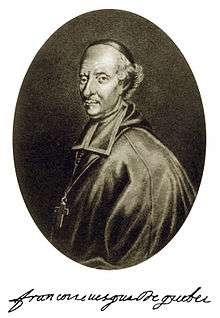
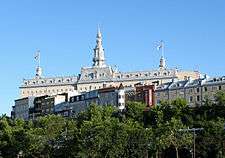
The university began as the Séminaire de Québec, which was founded in 1663 by François de Montmorency-Laval, a member of the House of Laval and the first Bishop of New France.[3]
During the French Regime the institution mainly trained priests to serve in New France. After the Conquest of 1760, the British expanded education in Canada to include the liberal arts. French Canadians had at the time no opportunity to pursue higher education, and Bishop Bourget of Montreal suggested expanding the Séminaire de Québec into Université Laval. Louis Casault, a priest who taught physics at the Séminaire de Québec, went to Europe to seek a royal charter and study the best university systems there.
The Séminaire de Québec was granted a royal charter on December 8, 1852, by Queen Victoria, at the request of Lord Elgin (Governor-General of the Province of Canada), creating Université Laval with "the rights and privileges of a university".[4] The charter was signed in 1852. Pope Benedict XV approved the plan and authorized the institution to establish chairs of theology and confer degrees.[5]
In 1878, the university opened a second campus in Montreal, which became the Université de Montréal on May 8, 1919, by a writ of Pope Benedict XV. In 1971, a second charter transferred all authority to the Université Laval council.[4]
By 1925, the university had outgrown its location. The Old City was very crowded, making it difficult to add new buildings to the campus. The university moved to Sainte-Foy in the 1950s, which at the time was a semi-rural community west of the Quebec city centre. The School of Architecture returned to the old building (now affectionately referred to as Le Vieux Séminaire) in 1989.
Université Laval is governed by a board of governors and a faculty senate. This structure was modelled on the provincial University of Toronto Act of 1906, which established a bicameral system of university government consisting of a senate (faculty), responsible for academic policy, and a board of governors (citizens) exercising exclusive control over financial policy and having formal authority in all other matters. The president, appointed by the board, was to serve as a link between the two bodies and lead the institution.[6]:306
In the early part of the 20th century, the need for higher education expanded beyond the classical fields of theology, law and medicine, and the university introduced science and social-science departments such as forestry and household science.[6]:1904 In addition, graduate training based on the German-inspired American model of specialized course work and the completion of a research thesis was introduced.[4]
"Laval", a waltz by French-Canadian ragtime composer, Wilfrid Beaudry, was dedicated to the students at Laval University and the University of Montreal. The music for piano was published in Québec by J. Beaudry, circa 1906.[7]
The university opened its department of social, political, and economic sciences in 1938, signalling a change of approach that continued into the 1960s, based on an idea of higher education as the key to social justice and economic productivity for individuals and society.[8]
The royal charter that founded Université Laval in 1852 was designated a National Historic Event in 1972.[9]
Buildings and features
The original campus on St. Denis Street was designed by Maurice Perrault in 1893–94.[10] Joseph Simeon Bergeron (architect) designed several buildings at Laval University including the School of Chemistry (1923), the addition on Ste. Famille Street (1931), the Mining School (1938), and the cafeteria building (1945).[11]
Today's campus covers 1.2 km2 (0.46 sq mi) and has over 30 buildings, including many iconic exemplars of modern architecture, all linked by 10 km (6.2 mi) of underground walkways, which are particularly useful in the winter and whose walls are mostly covered by murals and graffiti. The campus and its earliest buildings were designed by Edouard Fiset (fr), and of its lands, 56 percent are wooded areas, grasslands, and sports fields. It is also home to the Roger-Van den Hende botanical garden which contains some 67 species of deciduous and coniferous trees and 60 different species of birds.
Apart from the school of architecture in Old Quebec, the only out of campus facilities are the school of visual arts in Saint-Roch's district and the experimental Montmorency forest (fr) (70 km (43 mi) north of Quebec City).
Laval University also hosts a branch of the National Archives of Quebec, inside Louis-Jacques-Casault Hall.
Campus gallery
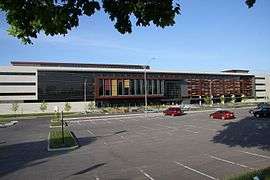 Ferninand Vandry Pavilion, hosting health sciences faculties
Ferninand Vandry Pavilion, hosting health sciences faculties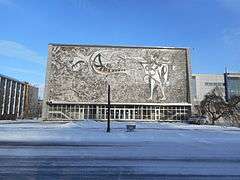 L'Homme devant la Science (1963), mural by Jordi Bonet on Adrien-Pouliot Hall
L'Homme devant la Science (1963), mural by Jordi Bonet on Adrien-Pouliot Hall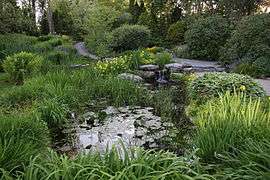 Water Garden at Roger-Van den Hende botanical garden
Water Garden at Roger-Van den Hende botanical garden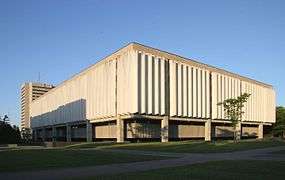 Social science library building
Social science library building Palasis-Prince building (administrative sciences)
Palasis-Prince building (administrative sciences)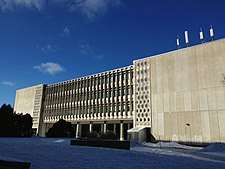 Pavillon Charles-De Koninck (social sciences and law)
Pavillon Charles-De Koninck (social sciences and law) Abitibi-Price building (forestry, geography and geomatics)
Abitibi-Price building (forestry, geography and geomatics)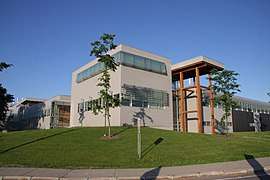 Gene-H.-Kruger building (wood research)
Gene-H.-Kruger building (wood research) Olympic swimming pool (PEPS building)
Olympic swimming pool (PEPS building)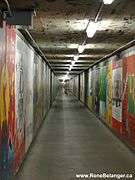 Pedestrian tunnel
Pedestrian tunnel- Félix-Antoine-Savard and educational sciences buildings
 Westernmost part of the campus
Westernmost part of the campus
Programs
As of 2002, Université Laval offered over 350 programs to more than 38,000 students. The university also attracts more than 2,500 foreign students annually, and has almost 1,000 students drawn from Canadian provinces outside of Quebec. Many students come to the university for the Français pour non-francophones program that offers instruction in French as a second language to students from Canada and around the world. It is also the only university in Quebec which trains forestry engineers. Since the mid-1980s, Université Laval has offered distance learning; over 30 programs and 400 courses are offered by distance learning, of which 80% are accessible from the internet.
Faculties and schools
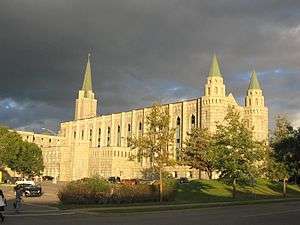
- Administrative Sciences
- Agriculture and Food sciences*
- Architecture, Urban planning and Visual arts
- Dentistry
- Education
- Faculté de Droit (Faculty of Law)
- Faculté des Lettres (Humanities)
- Forestry, Geography and Geomatics**
- Hautes Études Internationales (HEI)
- Arts
- Medicine
- Music
- Nursing
- Pharmacy
- Philosophy
- Postgraduate Studies
- Science and Engineering
- Agroenvironmental Engineering, Agricultural Engineering, Chemical Engineering, Civil Engineering, Electrical Engineering, Mechanical Engineering, Geology and Geological Engineering, Computer Engineering, Metallurgical Engineering, Mining Engineering, Physics, Chemistry, Water Engineering, Forest Engineering, Geomatics [12]
- Social Sciences
- Theology and Religious Studies
* The Département des Sciences des Aliments et de Nutrition has an accredited dietetic program. The university is accredited by a professional organization such as the Dietitians of Canada and the university's graduates may subsequently become registered dietitians.
** The Faculty is part of the AUFSC and has accredited baccalaureate of science programs with specializations in forestry & environmental management; forestry operations (co-op) and forestry engineering.
| University rankings | |
|---|---|
| Global rankings | |
| ARWU World[13][14] | 201–300 |
| QS World[15] | 402 |
| Times World[16] | 251–300 |
| U.S News & World Report Global[17] | 296 |
| Canadian rankings | |
| ARWU National[13] | 10–12 |
| QS National[15] | 15 |
| Times National[16] | 11–14 |
| U.S News & World Report National[17] | 13 |
| Maclean's Medical/Doctoral[18] | 11 |
| Maclean's Reputation[19] | 16 |
Canada Excellence Research Chairs
Québec university holds four of the 19 Canada Excellence Research Chairs awarded nationwide: Canada Excellence Research Chair in Remote Sensing of Canada's New Arctic Frontier, Canada Research Excellence Chair in the Microbiome-Endocannabinoidome Axis in Metabolic Health, Canada Excellence Research Chair in Photonic Innovations, and Communication and Canada Excellence Research Chair in Neurophotonics.[20]
University press
Les Presses de l'Université Laval, which was founded in 1950, deals with Canadian civilization, literature, medieval studies, law, social sciences, physical sciences and engineering.[21] It publishes some 120 book per year.[22]
University cooperative
The Coopérative de l'Université Laval is engaged in the sale of products to customers throughout the university, such as books, lecture notes and computers.
Athletics and sports teams
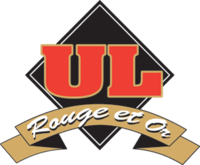
Athletics take place at the PEPS complex. Laval's varsity sports teams are named the Rouge-et-Or (Red & Gold). The men's football team was the 2013 Canadian champion and won seven Vanier Cups in ten years from 2003 to 2013.
Notable people
Public figures, including Prime Ministers of Canada, Premiers of Quebec, Supreme Court Justices, federal Cabinet Ministers, Senators, and Lieutenant-Governors as well as national and international athletes have graduated from l'Université Laval. Some of the more prominent are:
- Prime Ministers of Canada Louis St. Laurent, Brian Mulroney and Jean Chrétien
- Premiers of Quebec Lucien Bouchard, Pierre-Joseph-Olivier Chauveau, Edmund James Flynn, Jean Lesage, René Lévesque, Pauline Marois, Simon-Napoléon Parent and Louis-Alexandre Taschereau
- Supreme Court Justices Suzanne Côté, Louis LeBel, Claire L'Heureux-Dubé, Charles Fitzpatrick, Arthur Cyrille Albert Malouin, Lawrence Arthur Dumoulin Cannon, Louis-Philippe Pigeon, Julien Chouinard, Robert Taschereau, Henri-Elzéar Taschereau, Thibaudeau Rinfret
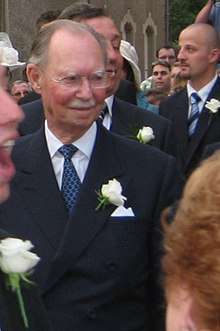
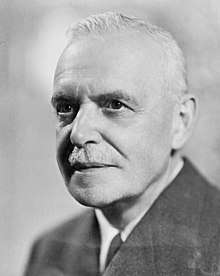
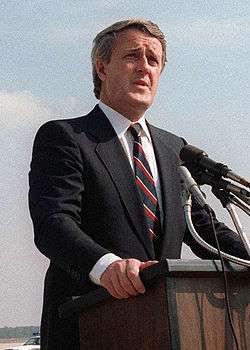 Brian Mulroney, 18th Prime Minister of Canada.
Brian Mulroney, 18th Prime Minister of Canada.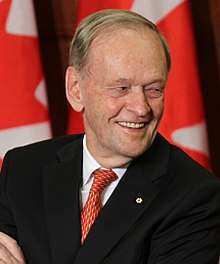 Jean Chrétien, 20th Prime Mininister of Canada.
Jean Chrétien, 20th Prime Mininister of Canada.
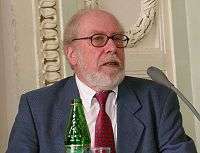 Niklaus Wirth, designer of several programming languages.
Niklaus Wirth, designer of several programming languages.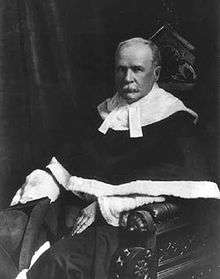
See also
- List of rectors of Université Laval
- List of universities in Quebec
- List of universities in Canada
- Group of Thirteen (Canadian universities)
- Laval Thomism
- List of oldest universities by region
- Quebec City
- Canadian university scientific research organizations
- Higher education in Quebec
- CHYZ campus radio station
References
- 1 2 3 "Quelques chiffres". Université Laval.
- ↑ Université Laval. "Université Laval at a Glance". (accessed 17 April 2007)
- ↑ "The Project Gutenberg eBook of The Makers of Canada: Index and Dictionary of Canadian History, Edited by Lawrence Johnstone Burpee and Arthur G. Doughty". Retrieved 28 August 2015.
- 1 2 3 Laval University/Université Laval Archived 2007-08-16 at the Wayback Machine.
- ↑ The Project Gutenberg EBook #6466 of 'The Intellectual Development of the Canadian People, A historical review' by John George Bourinot, House of Commons, Ottawa, February 17th, 1881
- 1 2 Langton, Hugh Hornby; Macallum, Archibald Byron (1906). The University of Toronto and its colleges, 1827-1906. The University Library, pub. by the librarian.
- ↑ Wilfrid Beaudry (1906). "Laval". Amicus.collectionscanada.gc.ca. Retrieved July 1, 2016.
- ↑ Behiels, Michael, "Le père Georges-Henri Lévesque et l'établissement des sciences sociales à Laval: 1938–1955", Revue de l'Université d'Ottawa 52, no. 3 (juil.-sept. 1982). Appears in English translation in "Youth, University, and Canadian Society", edited by Paul Axelrod and John G. Reid. Kingston and Montreal: McGill-Queen's University of Press, 1989.
- ↑ National Historic Event
- ↑ "Perrault, Maurice". Retrieved 28 August 2015.
- ↑ "Bergeron, Joseph Simeon". Retrieved 28 August 2015.
- ↑ Canadian Engineering Memorial Foundation – University List Archived 2007-03-24 at the Wayback Machine.
- 1 2 "Academic Ranking of World Universities 2018". ShanghaiRanking Consultancy. 2018. Retrieved 18 August 2018.
- ↑ "ARWU World Top 500 Candidates 2018". ShanghaiRanking Consultancy. 2018. Retrieved 18 August 2018.
- 1 2 "QS World University Rankings - 2019". QS Quacquarelli Symonds Limited. 2018. Retrieved 8 June 2018.
- 1 2 "World University Rankings 2019". Times Higher Education. TES Global. 2018. Retrieved 26 September 2018.
- 1 2 "Best Global Universities in Canada". U.S. News & World Report. U.S. News & World Report, L.P. October 2017. Retrieved 26 October 2017.
- ↑ "University Rankings 2019: Canada's top Medical/Doctoral schools". Maclean's. Rogers Media. 11 October 2018. Retrieved 13 October 2018.
- ↑ "Canada's Top School by Reputation 2019". Maclean's. Rogers Media. 11 October 2018. Retrieved 13 October 2018.
- ↑ "Canada Excellence Research Chairs". www.cerc.gc.ca. Retrieved March 29, 2017.
- ↑ University Presses Archived 2011-06-08 at the Wayback Machine.
- ↑ "Presses de l'Université Laval - Editeur de livres universitaires". Pulaval.com. Retrieved 2018-07-16.
External links
| Wikimedia Commons has media related to Université Laval. |
- Official website
- Bibliothèque de l'Université Laval
- Université Laval Foundation
- Faculty of Forestry, Georgraphy and Geomatics


Coordinates: 46°46′48″N 71°16′29″W / 46.78000°N 71.27472°W
